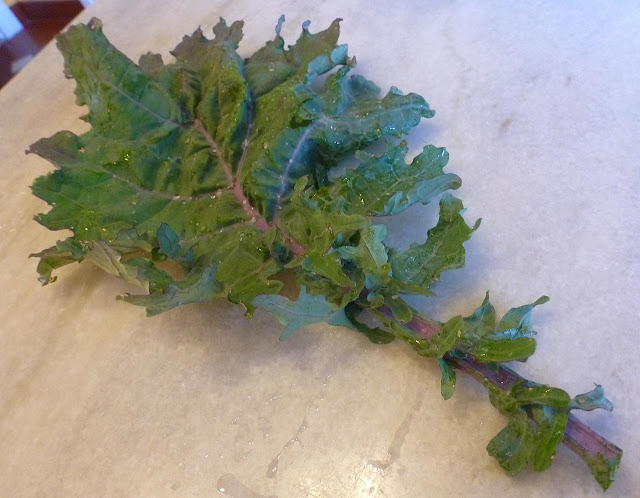I know I'm kind of repeating myself, but this is what I have to blog about right now — greens. I've posted similar recipes before. By the way, the pain in my shoulder is less severe now, thanks to paracetamol (called Tylenol in the U.S.) and ibuprofen, and maybe the antiviral medication too. I'm optimistic.
Yesterday morning, after my walk with the dog and while the temperature was relatively cool, I went out to the garden and cut enough kale leaves to fill a big laundry basket. It took me all of ten minutes. I'm so happy I discovered Red Russian Kale — the kale leaves are much like very tender collard greens.
I washed them, which was easy, because since it hasn't rained in... forever, the leaves were clean — hardly any dirt or sand, and no insects, snails, slugs, or caterpillars. I wash them with the shower attachment in the bathtub, which we never use for any thing but watering houseplants or washing greens, and then again in the kitchen once they are prepared for cooking.
Then I removed the thick red rib that runs down the middle of the Red Russian Kale leaves. You can see it in the photos above and to the left. It's pretty easy. The green part of the leaf is delicate enough that all you have to do is grab the bottom of the rib and pull the leaves through the thumb and index finger on your other hand. Discard the ribs.
Then I roughly chopped and weighed the de-ribbed leaves — I had 500 grams (just over a pound) of them. I sliced some shallots (onion would do) and garlic and started sauteeing them in olive oil in a big pot. I added about a tablespoon of cumin, the same amount of sweet paprika, along with a teaspoon each of black pepper, salt, and hot red pepper. Vary the seasoning to your taste.
The next step is to toss the greens into the pot and let them start to wilt and cook down. Add a little bit of water and/or white wine, as well as a cup or less of tomato sauce, and keep the greens just slightly wet as they cook.
At the end of the cooking time, the amount of which depends on how young and tender your raw greens were — taste them to see if they are tender to your taste — toss in a small can of cooked chickpeas (about half a pound) and a handful of toasted breadcrumbs. A splash of vinegar is also a good thing to add.
The breadcrumbs will absorb any cooking liquid left in the pot. Add a little more water if you think the mixture is too dry. This kind of dish would be just as good with red kidney beans, white beans, black-eyed peas, black beans, or pinto beans... for example.
You can also make such a dish using spinach or chard, which will require less cooking time, or with collard greens, which will need longer cooking. The tomato sauce and white wine will add sweetness, and the spices will perk everything up. The greens will be delicious, and beans are always good for you — as are greens.
Somebody who doesn't usually like greens might enjoy this spicy version. It can be served as a main course or as a side dish.


















































